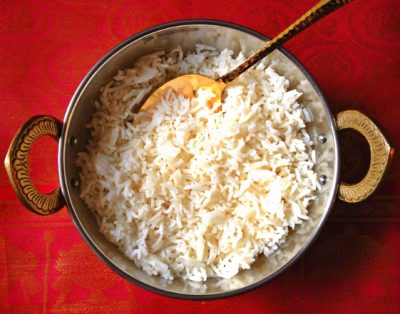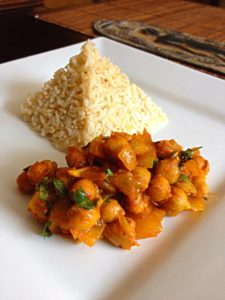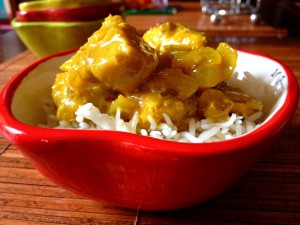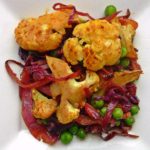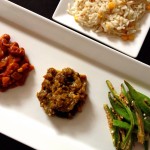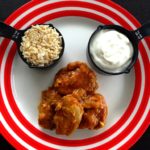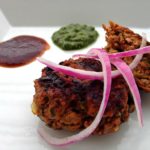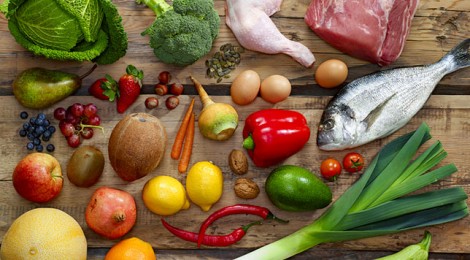
Paleo? Vegan? Pegan? Whichever way you eat, go Indian

Have you heard of the Pegan diet? It’s the latest eating approach that combines the Paleo diet and the Vegan diet (Photo source: Women’s Health Magazine)
Hello everyone! It’s Sean here. Happy New Year! If you’re like most of us, you’ve probably made a New Year’s resolution to lose weight or at least to eat better this year. But deciding between the various competing diets out there is a daunting task. Three popular choices at the moment — the Paleo diet, Veganism, and their odd offspring, the Pegan diet — all claim to provide the last word on healthy eating.
It’s said that politics, religion, and nutrition elicit the most visceral responses from people. Big Apple Curry doesn’t subscribe to the Paleo, Vegan, or Pegan diets, or any diet, for that matter. Our goal is to show folks how to use Indian spices, herbs, and cooking techniques through our most favorite homemade dishes. Ina and I hardly nutritionists, but we know a thing or two. If you’re simply looking to eat better this year, all of these eating approaches will serve you well, so you can’t go wrong. Here’s the skinny (no pun intended) on each of them, if you need help making sense of them. And even better, some of our tastiest homemade Indian recipes fit in perfectly with each one.
Going Paleo?

Photo Source: janeshealthykitchen.com
One of the more popular diets in recent years is the Paleo diet. This approach restricts the foods you can eat to those it claims our ancient ancestors ate 2.5 million years ago, such as meat, nuts, certain vegetables and fruit. Basically, those foods humans ate in prehistoric times, before the introduction of farming, domestication of animals, and modern processed foods. This means no grains, legumes, bread, pasta, sugar, or certain types of root vegetables. The Paleo diet claims to provide a scientific basis for why we should eat this way: our bodies evolved to eat certain types of food (namely, those foods consumed by our paleolithic ancestors), so we should eat only those foods we are best adapted to digest. The benefits are supposed to include weight loss, more lean muscle, less inflammation in the body, better blood sugar regulation, and overall better health.

Photo Source: dietplan-101.com
At first glance, this sounds plausible: just as you should only fill your car with the type of gas it was designed it to process, so too you should only feed your body the foods it evolved to digest. Unfortunately, it turns out that the scientific facts don’t support the claims the Paleo diet makes about its scientific basis. Consider three general problems with it:
- First, humans have evolved in ways that affect the foods we can eat — perhaps the best example of this is the wide-spread mutation across humans for lactose tolerance, allowing humans to consume dairy throughout their lives (this ability used to “turn off” in early childhood).
- Second, the foods we eat — even those within accepted Paleo categories simply did not exist during the Paleolithic era. For example, cabbage, broccoli, cauliflower, Brussels sprouts and kale are all examples of foods that didn’t exist in the past — they have all been selectively bred by humans from a common ancestor.
- Third, our bodies have adapted to eat many different types of food. When we look at our Paleolithic ancestors, some ate whale meat and blubber, others ate animal species that no longer exists in North America (they certainly were not eating modern chickens!), while others ate mainly seeds, nuts, fruits and vegetables. So who’s diet are we supposed to follow exactly?
However, this doesn’t mean that the Paleo diet health benefits are not backed up by science, or that it doesn’t offer a sensible way of eating. In fact, there is plenty of evidence that following a Paleo diet is good for overall health and weight loss loss. What science doesn’t support is the diet’s explanation as to why this happens — namely, that since the Paleolithic era, our bodies evolved to eat the foods our ancestors ate back then so therefore, we should adopt the diet they had at that time. But the paleo diet eliminates modern processed foods from your diet, restricts sugar consumption, and encourages us to eat healthy proteins, lots of vegetables, and healthy fats, which are all good things. And by ruling out, or severely limiting calorie-dense foods such as pasta, grains (including bread), potatoes, and legumes, it helps ensure that you do one of the most important things to lose weight: restrict the overall number of calories you eat.
Suggested Paleo Recipe: Daddy’s Chicken Curry
This is a super healthy dish that is compatible with Paleo diets (just leave out the potatoes if your preferred version of the Paleo diet avoids them), and it’s gluten-free to boot. Combine it with Indian roasted vegetables and you’re good to go. It takes no more than 30-40 minutes to get on the table, which makes for a wonderful and easy meal that’ll make healthy eating a snap.
Going Vegan?
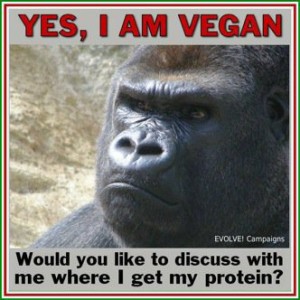
Photo Source: mrandmrsadventure.com
Veganism only permits foods that are plant-based, like fruits, vegetables, legumes, and nuts, and avoids all animal-based food, including dairy products. It is more restrictive than Vegetarianism (which allows for dairy). And it’s more restrictive than the Paleo diet in many ways.

Photo Source: chooseveg.com
That said, Veganism has many followers, either due to ethical concerns (vegans do not wish to harm animals for food or clothing) or for health reasons. We won’t wade into the debate about whether Veganism is the healthiest approach to eating here. Suffice to say, that if you are moving from a typical North American diet of processed foods, substandard proteins, limited fruits and vegetables, and lots of sugar to a well-rounded Vegan diet, you’ll see some great health benefits. There are a number of high-profile Vegans, like President Bill Clinton, who successfully reversed his serious heart condition by becoming vegan. Like the paleo diet above, it is likely that many of the health benefits of Veganism are simply a result of eliminating processed foods, limiting sugar consumption, and introducing lots of fresh vegetables, unprocessed nuts, and good fruit.
Suggested Vegan Recipe: Channa Masala
This is a classic Vegan dish in Indian cuisine. Note that this is not Paleo-friendly (it uses legumes), but if you are vegetarian, vegan, or avoiding gluten, it is a fantastic, delicious dish. It should definitely become a staple of your diet if it works with your preferred plan.
Going Pegan?

The latest thing (Photo source: Diets in Review)
We were flying American Airlines recently when I saw an article in the in-flight magazine called Going Pegan. It combines the Paleo diet with Veganism. This was news to us, but apparently it’s all the rage and you might have chosen it as your New Year diet. I must admit that combining a vegan diet with anything that includes animal products is strange to me. According to the article, the Pegan diet “takes the best of both the Paleo and Vegan diets to create a balanced, sustainable, easy-to-follow way of eating that makes the most sense for our overall health.” Ok. But given that Veganism strictly bans all animal products, often for strong ethical reasons, it strikes me as a little disingenuous, and really more about marketing rather than good nutritional science. But, leaving aside the aspect of the diet designed to sell books, it does represent a pretty sensible way of eating.
On a Pegan diet, if you picture an average-sized dinner plate, most of it will consist of vegetables and fruits (75%) with a small portion of “sustainably raised or grass-fed” animal products (25%). A typical Pegan’s plate would look like this:
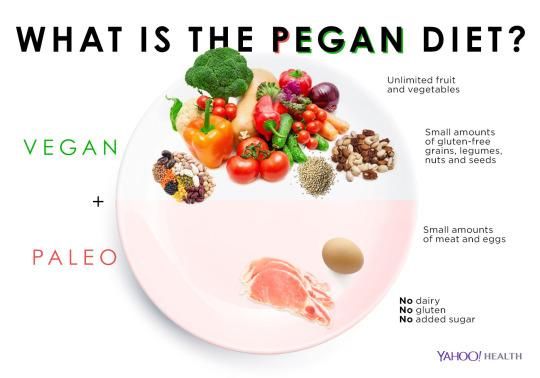
Photo Source: yahoo.com
Like many forms of the Paleo diet and Veganism, the Pegan diet encourages fat-rich foods like avocados, olive oil, coconut, raw nuts and seeds. Here are the main rules for a Pegan:
- Canola, sunflower, corn and soybean oil are discouraged, instead encouraging one to “cook with ghee (if you’re not Indian, that’s clarified butter) or coconut oil and use extra-virgin olive oil to make salad dressings and to drizzle over cooked vegetables.”
- Legumes (chick peas) and grains (black rice) are quite limited (making it closer to Paleo)
- Dairy is avoided, with the exception of goat or sheep products that should be enjoyed “only as a treat”
- Maple syrup, honey and coconut sugar are considered OK if consumed in small amounts.
So what’s missing? Dairy, gluten, and added-sugar — no cheese, milk, yogurt or gluten-laden pasta or bread. Chocolate bars and Pepsi are definitely out. So again, we see that at root, the principle instructions of the Pegan diet are to eliminate processed foods, limit sugar, and eat whole foods like well-sourced proteins, ample fruits and vegetables, and healthy fats.
Suggested Pegan Recipe: Fish Curry with Coconut Milk
Fish, coconut milk, and rice with a few spices like turmeric and herbs makes for a terrific Pegan dish. Because this eating approach encourages ghee (clarified butter) or coconut oil over other oils, all you need to do is a) swap out the canola oil in this recipe for coconut oil and b) serve it over a little black rice (one of the few approved grains) and you can confidently call it Pegan.
Final Word
If you do nothing else this year, following the basic guidelines of eliminating processed foods, limiting sugar, eating healthier proteins and fats, and incorporating lots and lots of healthy, fresh vegetables and fruits will go extremely far in helping you lose weight and feel more healthy. And as you do so, look no further than Big Apple Curry for some healthy, tasty recipes that will fit into whatever diet you choose to follow.
